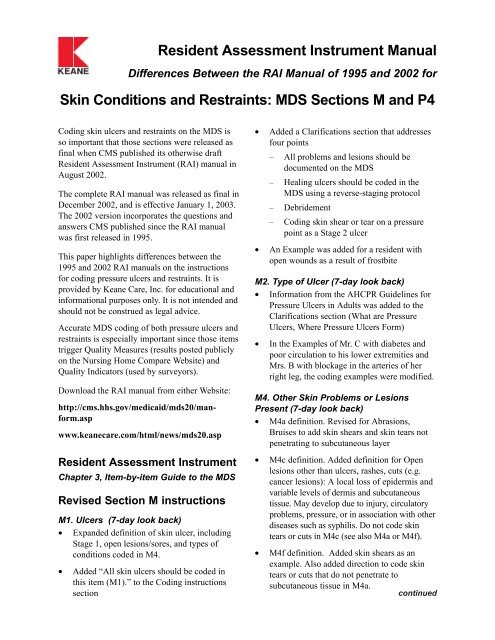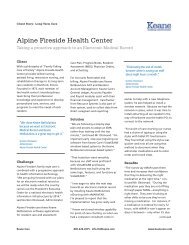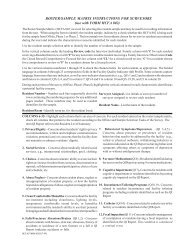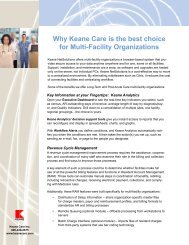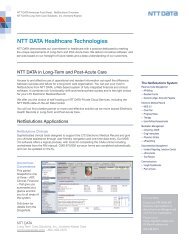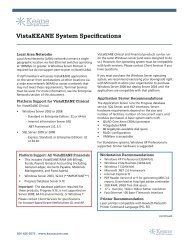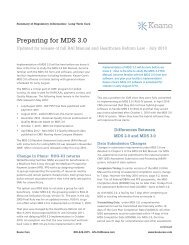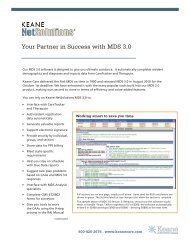Resident Assessment Instrument Manual
Resident Assessment Instrument Manual
Resident Assessment Instrument Manual
You also want an ePaper? Increase the reach of your titles
YUMPU automatically turns print PDFs into web optimized ePapers that Google loves.
<strong>Resident</strong> <strong>Assessment</strong> <strong>Instrument</strong> <strong>Manual</strong><br />
Differences Between the RAI <strong>Manual</strong> of 1995 and 2002 for<br />
Skin Conditions and Restraints: MDS Sections M and P4<br />
Coding skin ulcers and restraints on the MDS is<br />
so important that those sections were released as<br />
final when CMS published its otherwise draft<br />
<strong>Resident</strong> <strong>Assessment</strong> <strong>Instrument</strong> (RAI) manual in<br />
August 2002.<br />
The complete RAI manual was released as final in<br />
December 2002, and is effective January 1, 2003.<br />
The 2002 version incorporates the questions and<br />
answers CMS published since the RAI manual<br />
was first released in 1995.<br />
This paper highlights differences between the<br />
1995 and 2002 RAI manuals on the instructions<br />
for coding pressure ulcers and restraints. It is<br />
provided by Keane Care, Inc. for educational and<br />
informational purposes only. It is not intended and<br />
should not be construed as legal advice.<br />
Accurate MDS coding of both pressure ulcers and<br />
restraints is especially important since those items<br />
trigger Quality Measures (results posted publicly<br />
on the Nursing Home Compare Website) and<br />
Quality Indicators (used by surveyors).<br />
Download the RAI manual from either Website:<br />
http://cms.hhs.gov/medicaid/mds20/manform.asp<br />
www.keanecare.com/html/news/mds20.asp<br />
<strong>Resident</strong> <strong>Assessment</strong> <strong>Instrument</strong><br />
Chapter 3, Item-by-item Guide to the MDS<br />
Revised Section M instructions<br />
M1. Ulcers (7-day look back)<br />
• Expanded definition of skin ulcer, including<br />
Stage 1, open lesions/sores, and types of<br />
conditions coded in M4.<br />
• Added “All skin ulcers should be coded in<br />
this item (M1).” to the Coding instructions<br />
section<br />
Differences between 1995 and 2002 RAI <strong>Manual</strong> - 1<br />
• Added a Clarifications section that addresses<br />
four points<br />
– All problems and lesions should be<br />
documented on the MDS<br />
– Healing ulcers should be coded in the<br />
MDS using a reverse-staging protocol<br />
– Debridement<br />
– Coding skin shear or tear on a pressure<br />
point as a Stage 2 ulcer<br />
• An Example was added for a resident with<br />
open wounds as a result of frostbite<br />
M2. Type of Ulcer (7-day look back)<br />
• Information from the AHCPR Guidelines for<br />
Pressure Ulcers in Adults was added to the<br />
Clarifications section (What are Pressure<br />
Ulcers, Where Pressure Ulcers Form)<br />
• In the Examples of Mr. C with diabetes and<br />
poor circulation to his lower extremities and<br />
Mrs. B with blockage in the arteries of her<br />
right leg, the coding examples were modified.<br />
M4. Other Skin Problems or Lesions<br />
Present (7-day look back)<br />
• M4a definition. Revised for Abrasions,<br />
Bruises to add skin shears and skin tears not<br />
penetrating to subcutaneous layer<br />
• M4c definition. Added definition for Open<br />
lesions other than ulcers, rashes, cuts (e.g.<br />
cancer lesions): A local loss of epidermis and<br />
variable levels of dermis and subcutaneous<br />
tissue. May develop due to injury, circulatory<br />
problems, pressure, or in association with other<br />
diseases such as syphilis. Do not code skin<br />
tears or cuts in M4c (see also M4a or M4f).<br />
• M4f definition. Added skin shears as an<br />
example. Also added direction to code skin<br />
tears or cuts that do not penetrate to<br />
subcutaneous tissue in M4a.<br />
continued<br />
Keane Care
• M4g definition: Added to last sentence of<br />
Surgical Wounds: This category does not<br />
include …“lacerations that require suturing or<br />
butterfly closure as surgical wounds.”<br />
• Added to Coding section: Multiple items may<br />
be checked only when coding for multiple<br />
skin conditions. For example, a skin tear can<br />
be coded in M4a or M4f,not both. Ulcers<br />
coded in M2 should not be coded in M4.<br />
• Added new Clarifications section: “It may be<br />
difficult to distinguish between an abrasion<br />
and a skin tear/shear if you did not witness the<br />
injury. Use your best clinical judgment to code.”<br />
M5. Skin Treatments (7-day look back)<br />
• M5d definition: added that vitamins and<br />
minerals used to manage a potential or active<br />
skin problem, such as Vitamin C and Zinc,<br />
should be coded here.<br />
• Added a Clarifications section:<br />
– Good clinical practice dictates that staff<br />
should document treatment listed in MDS<br />
Item M5 and M6.<br />
– Dressing applied even once during the 7-<br />
day period can be checked.<br />
M6. Foot Problems, Care (7-day look back)<br />
• Definition added for M6a. <strong>Resident</strong> has one<br />
or more Foot Problems… “includes ulcerated<br />
areas over plantar’s warts on the foot.”<br />
• Clarification was added: For MDS coding,<br />
ankle problems are not considered foot<br />
problems and should NOT be coded in Item<br />
M6. Code in M5.”<br />
Restraints<br />
P4. Physical Restraints (7-day look back)<br />
• Added a second sentence to Intent: “The<br />
intent is to evaluate as part of the assessment<br />
process whether a device meets the definition<br />
of a physical restraint and then to code only<br />
those devices categorized in section P4 that<br />
have the effect of restraining the resident.”<br />
• P4b definition. Expanded definition of Other<br />
Types of Bed Rails Used to include “Any<br />
Differences between 1995 and 2002 RAI <strong>Manual</strong> - 2<br />
combination of partial rails or partial/full rails<br />
not covered by P4a (Full Bed Rail)<br />
• P4d definition. Added to definition of Limb<br />
Restraint: “Include in this category mittens.”<br />
• P4e definition. Revised definition of Chair<br />
Prevents Rising to replace “Includes ‘comfort<br />
cushions’ (eg, lap buddy), ‘merry walkers.”<br />
with “Include in this category enclosed<br />
framed wheeled walkers with or without a<br />
posterior seat. and lap cushions that a resident<br />
cannot easily remove.”<br />
• Process. Added: Assessor should not focus<br />
on intent or reason for device, but on the<br />
device’s effect on the resident. If the device,<br />
material, or equipment meets definition of<br />
restraint, code it in appropriate category.<br />
• Coding. Added information to section:<br />
– While a device may not be completely<br />
representative of the category description,<br />
follow the coding instruction as given. For<br />
devices that are not covered by a category,<br />
do not code now, “but note that<br />
subsequent versions of the MDS will<br />
include an ‘other’ category.”<br />
Also added a note that restraints must have<br />
a medical symptom that warrants their use,<br />
a physician’s order, and must be care<br />
planned, even if there is no MDS category.<br />
– Exclude from P4 items used to provide<br />
medical care, such as catheters, drainage<br />
tubes, casts, traction, braces, and bandages.<br />
• Added a Clarifications section that addresses<br />
– <strong>Resident</strong>s who are cognitively impaired<br />
– The Merry Walker and similar devices<br />
that “should not be categorically<br />
classified as a restraint.” If these devices<br />
assist ambulation, they should be coded as<br />
a cane/walker/crutch at G5a, whether or<br />
not they are coded as a restraint.<br />
– Coding when a device is and is not a restraint<br />
– Request for restraints<br />
– Are restraints prohibited?<br />
– Bed rails used as positioning devices<br />
– Devices used with immobile residents:<br />
side rails, geriatric chairs<br />
Keane Care


